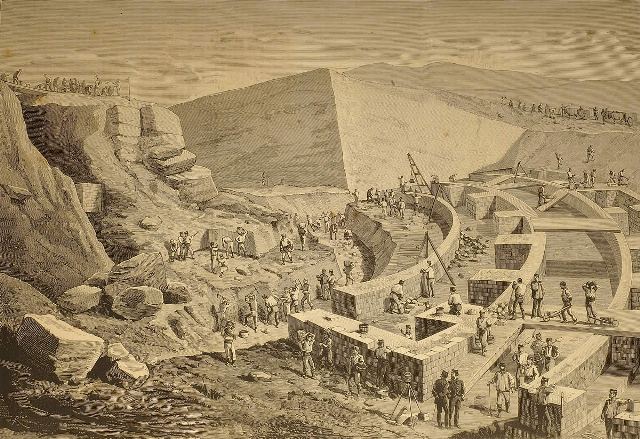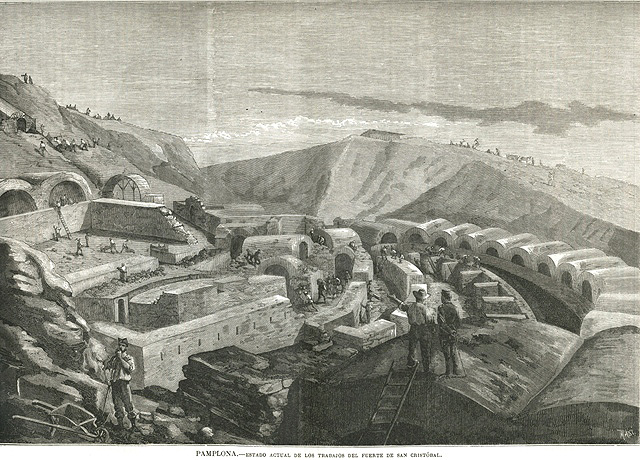Piece of the month of May 2010
THE Building OF THE FORT OF ALFONSO XII BY NEMESIO LAGARDE IN THE SPANISH AND AMERICAN ILLUSTRATION AND MILITARY ILLUSTRATION (1881-1882)
Esther Elizalde Marquina
Chair of Navarrese Heritage and Art
The illustrious capital of the ancient kingdom of Navarre, which had always been one of the most imposing strongholds of the Iberian Peninsula, an impregnable city, according to The Spanish and American Enlightenment and American Enlightenment in 1881, had lost its effectiveness in the face of the new techniques of warfare. The last Carlist War (1872-1876) demonstrated the defensive incapacity of the old walled enclosure in Pamplona, which was definitively accepted by the military. The bombardments that the supporters of the Pretender directed at the capital of Navarre from the summit of Mount San Cristóbal in May and October 1875 confirmed the need to reinforce the defences of "the key to the Kingdom". For this reason, at the end of the war, it was decided to build a fort located at cima on the aforementioned mountain due to its strategic and tactical status .
"When all nations are redoubling their efforts to increase the army, armaments and defensive conditions of their respective countries, it was necessary that we should no longer remain in our usual state of indolence. To these considerations pointed out by The Military Enlightenment responded to the Fort of Alfonso XII.
Named after the monarch during whose government it was designed and built (1878-1919), also known as the Fort of San Cristóbal, it was designed and directed by the Commander of Engineers José Luna y Orfila, who was succeeded by Colonel Miguel Ortega conference room (1901-1906) and later by the Engineer Commander of Pamplona Antonio Los Arcos y Miranda (1908-1918). Fundamentally offensive in nature, the main objectives of the fortress were: to resist enemy artillery and infantry attacks, to have the capacity for self-defence, to prevent the enemy from approaching the Pamplona Basin and to occupy the summit of the hill.
Thanks to the two engravings we present here, published in The Spanish and American Enlightenment y The Military Enlightenment between 1881 and 1882, respectively, we can see the progress of the work on the fortress during these years.
The first of them belongs to Nemesio Lagarde y Carriquiri (1845-Toledo, 1902) from Pamplona, published by La Ilustración Española and American in April 1881. Born in 1845 in the capital of Navarre, Nemesio Lagarde was part of the most select cultural group of the city during his youth, together with his brother Aniceto. In 1864, he entered the special Academy of the Corps of Engineers of Guadalajara, graduating in 1870. He actively participated in the last Carlist War with the Army of the North. After the completion of his programs of study in military engineering, his degree program was ascending, being named Captain in 1883, Commander in 1895 and, finally, in 1902 he received the insignia of Lieutenant Colonel, as Urricelqui Pacho recounts in Memories of a civil war. Album of the blockade of Pamplona. In addition to all this, he was awarded important decorations such as the Cross of San Hermenegildo obtained in 1898.
As for his artistic facet, evident from his youth, we highlight his work as professor of Drawing at the General Military Academy of Toledo from 1883 to 1892, where he was described as an "artist to the marrow", and was conferred various honors. He also published several books on military engineering.
However, it is his work as a graphic illustrator that interests us here. He began during the Third Carlist War with the sending of several drawings to The Spanish and American and Americanhe came to be considered as one of its graphic correspondents, continuing his partnership after the end of the war. In the aforementioned magazine and in La Ilustración Militarwhich corroborates his quality as a graphic illustrator. In this last publication he carried out both original illustrations, starting from his sketches taken from nature (après nature) and then transferred to engraving, and reworkings of drawings sent by soldiers stationed on the different fronts, who served as war correspondents; in this way, Lagarde exercised an occupation typical of the "Staff Artist or cabinet artists".
Focusing on the lithograph of 1881, Nemesio Lagarde sample us the state of the works of the Fort of San Cristóbal in three different points of the mountain, focusing on the most advanced one, without forgetting to depict the work started at the cima.
Through the representation of the workers in their various occupations, he adds dynamism to the scene. He reproduces the different gestures and attitudes of the characters that make it up, showing that it is a sketch taken from nature, capturing a specific moment of the hard work workshop . Thus, we can appreciate in the foreground the calmness with which the military engineers converse while they watch over the work; the day laborers who walk near them with pick and shovel on their shoulders, or even one of their companions putting on his beret; contrasting with the effort of the laborers who pick stone, carry it in baskets, or those who do masonry work. He uses a precise drawing, of sure and detailed stroke, that allows us to distinguish the different attires of each portrayed personage, the tools or instruments, like the theodolite, the baskets where they transport the materials or the animals that raise the carts located in the upper right margin. In addition, this engraving perfectly documents that the initial works carried out in the fort consisted of leveling the land, in addition to the creation of the road and the water supply, a matter that will be verified when comparing it with the second engraving, where the large rocks and the mountainous concavity of the left margin no longer exist.
Well, the works presented here could correspond to the "Advanced Work of the West or Old Fort", being the first Building carried out on the Fort as a whole, according to Marrodán's description. In fact, in both prints two construction zones can be seen on the cima the hill, which in 1881 were less advanced than the main one.

Plate 1. Pamplona: Important defence work on the San Cristóbal encirclement, being carried out by the Corps of Military Engineers (Drawing by Mr. Nemesio Lagarde). La Ilustración Española y Americana, Madrid, 22nd April 1881. nº XV, p. 253.
The second lithograph was published by The Military Enlightenment in March 1882, signed by Masí (José Masí del Castillo), one of the most important woodcutters of the second half of the 19th century and partner of the most important magazines. However, if we remember Lagarde's work as a "cabinet artist", it may be that Masí del Castillo himself played the same role in this lithograph, reproducing one of Lagarde's own drawings, something very common at the time. We therefore raise the possibility, albeit with logical reservations, that the original author is Nemesio Lagarde, thesis , supported by several reasons: the identical perspective of the previous lithograph, slightly modified by the advances in the construction of the Fort, the dynamism of the scenes, as well as the attitude of the different characters; despite the fact that, to tell the truth, it loses a certain quality, sharpness and freshness in the drawing; and, finally, the confirmation that Lagarde regularly returned to Pamplona during his military leave to visit his family settled in Navarre.

Plate 2: Pamplona - Current state of work on the Fort of San Cristóbal (Masi). La Ilustración Militar: revista literaria, científica y artística, Madrid, March 1882, no. 18, p. 301.
The Military Enlightenment confirmed the progress made on the San Cristóbal hill, evident in the main scene, possibly the Old Fort, as well as the scenes at cima on the right-hand side, in which a small building can be seen, a larger issue of labourers at work and the animal-drawn carts; likewise, on the left-hand side, the mountainous concavity has apparently disappeared, replaced by a tunnel.
Although these engravings show the progress of the Fort of Alfonso XII in its early years of construction, it was not completed until 1919, by which time this fortification subject had become useless, due to the advances in the art of war that were clearly visible in the First World War with the introduction of aviation. All in all, the Fort of Alfonso XII or Fort of San Cristóbal was the last of the Navarrese capital's defences and the most important of its kind in Spain at the time, as well as being an excellent example of late 19th century military architecture.
bibliography
-MARRODÁN VITORIA, A., "El Fuerte de Alfonso XII en el monte de San Cristóbal" (The Fort of Alfonso XII on Mount San Cristóbal) in MurariaPamplona, Government of Navarre, department de Cultura y Turismo, Institución Príncipe de Viana, 2005, pp. 298-314.
-OSSORIO Y BERNARD, M., Biographical gallery of 19th century Spanish artistsMadrid, Giner, 1975.
-URRICELQUI PACHO, I. J., Recuerdos de una guerra civil. Álbum del bloqueo de Pamplona, Pamplona, Government of Navarre, 2007.
-LaIlustración Española y Americana, Madrid, 22 April 1881. nº XV, pp. 251- 253.
-LaIlustración Militar: revista literaria, científica y artística, Madrid, March 1882, no. 18, pp. 301-303.
